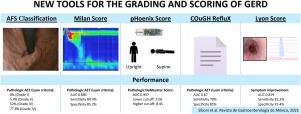胃食管反流病分级和评分的新工具。
Revista de gastroenterologia de Mexico (English)
Pub Date : 2025-07-01
DOI:10.1016/j.rgmxen.2025.09.005
引用次数: 0
摘要
胃食管反流病(GERD)是一种以胃内容物逆行流进食管为特征的常见疾病,严重影响生活质量。由于症状与其他疾病重叠,传统的诊断方法往往缺乏准确性。本文介绍了美国前肠学会(AFS)分类、米兰评分、凤凰评分、咳嗽反流评分和里昂评分,这五种新工具旨在提高GERD诊断的客观性、可重复性和临床相关性。AFS分类通过纳入可测量参数(裂孔疝长度、裂孔孔径直径和瓣瓣)来完善食管胃结(EGJ)完整性的内镜评估,克服了Hill分类的主观性。米兰评分来源于高分辨率测压法,整合了四个参数(无效食管运动、EGJ收缩积分、EGJ形态学和直腿抬高反应)来量化抗反流屏障(ARB)破坏。pHoenix评分是为长时间无线pH监测而开发的,它更重视仰卧AET,解决了DeMeester评分和Lyon 2.0共识的局限性。咳嗽反流评分是一种喉咽症状的临床预测模型,使用六个参数(咳嗽、肥胖、球体、裂孔疝、反流、男性)对反流可能性进行分层。最后,Lyon评分整合了内镜和ph阻抗数据,将患者分为表型(从无GERD到严重GERD),并预测治疗结果。这些工具通过标准化评估和改善患者分层来共同解决诊断挑战。通过减少诊断歧义和指导个性化治疗,这些创新有望改变胃食管反流病的管理,特别是在选择候选人进行升级的医疗或手术干预方面。本文章由计算机程序翻译,如有差异,请以英文原文为准。

New tools for the grading and scoring of gastro-esophageal reflux disease
Gastroesophageal reflux disease (GERD) is a prevalent condition characterized by the retrograde flow of gastric contents into the esophagus, significantly impacting quality of life. Traditional diagnostic approaches often lack precision due to symptom overlap with other conditions. This review introduces the American Foregut Society (AFS) classification, Milan score, pHoenix score, COuGH RefluX score, and Lyon score, five novel tools designed to enhance the objectivity, reproducibility, and clinical relevance of GERD diagnosis.
The AFS classification refines the endoscopic assessment of esophagogastric junction (EGJ) integrity by incorporating measurable parameters (hiatal hernia length, hiatal aperture diameter, and flap valve), overcoming the subjectivity of the Hill classification. The Milan score, derived from high-resolution manometry, integrates four parameters (ineffective esophageal motility, EGJ-contractile integral, EGJ morphology, and straight leg raise response) to quantify anti-reflux barrier (ARB) disruption.
The pHoenix score, developed for prolonged wireless pH monitoring, weights supine AET more heavily, addressing limitations of the DeMeester score and Lyon 2.0 consensus. The COuGH RefluX score, a clinical prediction model for laryngopharyngeal symptoms, uses six parameters (cough, obesity, globus, hiatal hernia, regurgitation, male sex) to stratify GERD likelihood. Finally, the Lyon score integrates endoscopic and pH-impedance data, categorizing patients into phenotypes (from no GERD to severe GERD) and predicting treatment outcomes.
These tools collectively address diagnostic challenges by standardizing assessments and improving patient stratification. By reducing diagnostic ambiguity and guiding personalized therapy, these innovations hold promise for transforming GERD management, particularly in selecting candidates for escalated medical or surgical interventions.
求助全文
通过发布文献求助,成功后即可免费获取论文全文。
去求助

 求助内容:
求助内容: 应助结果提醒方式:
应助结果提醒方式:


